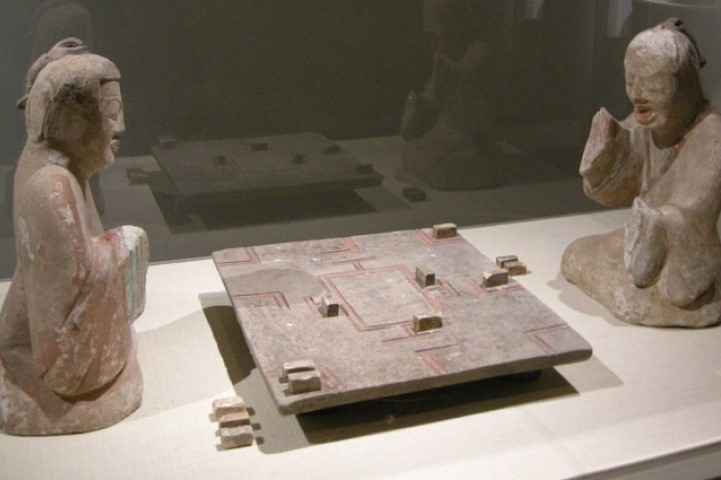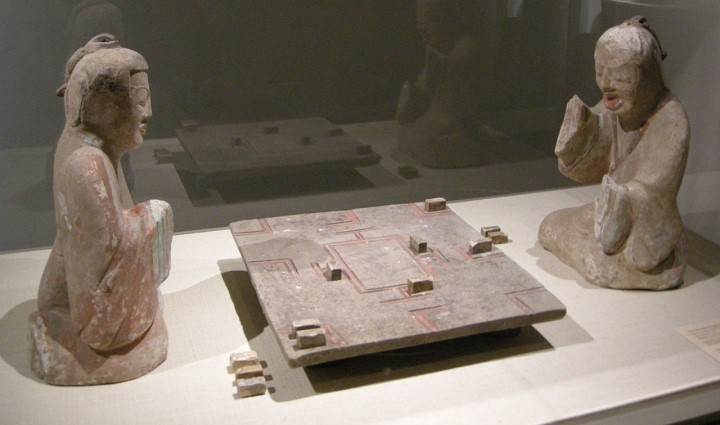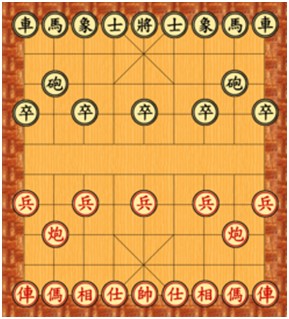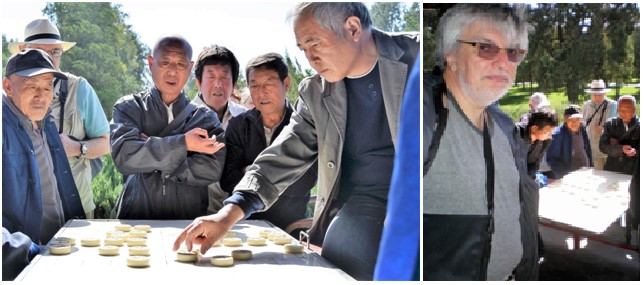


In case you missed them, see Part 1: An introduction and Part 2: Indian origin of chess
The investigation into a probable Chinese origin of chess has been the subject of a lesser degree of depth in comparison to a possible Indian origin. European researchers, particularly the British, did not ignore that chess was present in China in very ancient times, but always subordinated its existence to a previous game: chaturanga. In that sense, a French researcher, Louis Dubois,[1] argued in the nineteenth century that the game would have entered China from India, relying on a statement from the Haï-Piène — a massive dictionary — which ensures that xiang-qi entered China during the mandate of emperor Vou-ty in the year 537 of the Christian era.[2]
Without even entering into the analysis to determine the sequence of transmission between the Indian and Chinese cultures, it can be noted that, sharing an ancient tradition, the games in both cases originally appeared as similes of a battle. Although they could be also ascribed to higher planes: metaphysical, philosophical and religious.
Under this perspective, according to English sinologist Joseph Needham,[3] who is considered to be the precursor in assigning the paternity of chess to xiang-qi (still practiced massively in China), the game had a ritual nature. In this context the board that is used, most probably intimately linked to the surface where the ancient liubo[4] was developed, could be seen at the same time like a calendar or as an oracle — it responded to the ancestral techniques of fortune tellers.
Xiang-qi is explicitly mentioned for the first time in the year 569 of the Christian era in a text titled Xiang Jing (Xiang Game Manual), attributed to Emperor Wu Di (561-578) of the northern[5] Zhōu dynasty, who would also be the inventor of the game. The prologue of the text was written by Weng Pao — this prologue is the only conserved part of the text, of which there exists an English translation by Dennis Leventhal.[6]
We are in the presence of the first treatise referred to any of the known proto-chess variants. Compared with the earlier Indian and Persian texts that could have a similar didactic objective, it is much more precise since, for example, in its own title the game is mentioned. Although its content is not known in detail, it is supposed to include technical concepts and discussions on the implicit high values of the game from the philosophical, cultural and moral perspectives. For instance, it is suggested that when one has a position of honour one must be humble and, always on a plane of elevation, it ensures that the pieces represent celestial bodies of the cosmos.
In the same vein, a few years later the text known as Hsiang Hsi Fu appears, a manuscript authored by Yu Hsin, where the focus is again on the fact that emperor Wu Di is owed a game that symbolizes all the phenomena of human existence.
In attempting to determine the origin of xiang-qi, it is usually held that it is derived from another older autochthonous game, liubo.[7] But Cazaux[8] disagrees with this thesis because, although he does not rule out some kind of influence, since, for example, both are disputed on the same type of surface, he argues that in any case liubo operated like a contributor in the syncretic conception of chess, along with ashtāpada and petteia, so its link with xiang-qi would be rather indirect.

Statuettes probably from the first to the second century of the Christian era representing two players disputing a game of liubo. | Photo: Wikimedia Commons
There are several possible translations to the ideogram that represents the term xiang-qi (hsiang-chi). One of the best known, although it would be linguistically not very correct, is elephant chess, referring strangely to a piece that, participating in the battle, is not the main one. For several sinologists, however, the most appropriate translation is symbolic chess or image chess.
It is necessary to emphasize that qi means “game” (it is the same suffix that appears for example in wei-qi), although it is also more specifically associated to chess. It was also indicated that xiang-qi can be translated as ivory chess (alluding to the material that pieces are made of, or, again, due to its link with the elephant) or chancellor chess (alluding in this case to one of the main pieces).
David Li adds two more possible translations: as the term is so phonetically close to ciang, which means “general”, we could call it general's chess (the main piece in combat); and another more suggestive, game to capture Xiang, which is the name of the commander of the losing army in the battle that led to the foundation of the empire built under the dominions of the Han Dynasty.
It should be borne in mind that, in addition to shaping a playful structure in which a battle is represented, in xiang-qi we are also in the presence of an agonal struggle (or should we call it a struggle of complementarity?) between the Taoist concepts of yin and yang (Heaven and Earth) that come from the millennial I Ching. The link is quite narrow if one considers that there are 64 squares on the board, a number that perfectly coincides with the amount of hexagrams that form the base of the system of ideas in The Book of the Mutations, which refers to the old Chinese calendar as noted by Jing Fan in the first century before Christ.

Image of the 64 hexagrams of I Ching
Chinese chess received little attention from Western investigators in earlier times, perhaps because of a certain closure of that culture, which did not favour foreign scrutiny and thus was not the subject of a systematic investigation, contrasting with the Indian version of chess. Furthermore, there was additional difficulty in ascribing xiang-qi as a proto-chess variant, given the obvious differences in its design: it is not disputed on a 8x8 board but on a 8x9 board (in its centre, there is a horizontal line called river, which looks somewhat extravagant); the pieces do not have the form of statuettes, but they are circular tokens (which can prompt us to confuse it with some version of go); the pieces are located on the joints and not at the centre of the squares; the number of pawns is five, instead of eight; and there are two pieces that are absolutely atypical: the archer and the catapult.
However, when delving into its essential characteristics, it is clear that the similarities are much more relevant than the dissimilarities: it is played by two persons; the board is formed by 64 squares; the objective is to catch the leader of the rival force (the general[9] who can only move within a small space called the palace); there are 16 pieces for each participant; many of which are idiosyncratic: pawns, horses, elephants, chariots, which have the same movements as in, for example, chaturanga.
A legitimate question, first timidly drawn, but which has gained more strength over time, is whether xiang-qi is a derivative of Indian chess or whether the reverse is true. More recently, another suggestive alternative has been drawn: that they may have emerged concomitantly, in time, and of course independently, in space. In any case, the Chinese version of the game is undoubtedly part of a family that has a common root, from which chess was derived as it would come to be known later. What is still undetermined is whether it was the initial or intermediate link in the chain of creation.
The findings of further investigations may have unexpected consequences: researchers who once embraced the Indian theory mutated their position, and now understand that it is the Chinese who are owed the paternity of chess. This has happened, for example, with the Macedonian Pavle Bidev,[10] who changed his mind basically due to the dates of the first text of each culture with references to chess — year 569 in the Chinese case (that of Wan Pao) and year 621 in the Indian case (that of Bāṇa).[11]

Image of the board showing the starting position in xiang-qi
Looking for literary references to the game, Leventhal points out that, on a poetic level, in The Man of P'a-ch'iung[12] it is stated that, after an extraordinary frost, only two giant tangerine trees survived and, in the interior of their fruits, we see two elders very concentrated playing hsiang-hsi.[13] The author of this beautiful story is Niu Seng-ju (780-848), who became Emperor Wu Zong's prime minister of the powerful Tang dynasty. He is also said to have authored Hsü-kuai Lu (Accounts of Mysteries and the Supernatural), where the pieces that are used in the game are described — they were made of gold and bronze.
The terms xiang and qi, although separately, had been frequently mentioned in earlier times. It is believed that for the first time in Chu Ci (Songs of Chu) of Qu Yuan (known as the Homer of the Orient), a text that would have been written in the third century before Christ. Since the text also includes a reference to liubo (played with pieces of ivory and a dice made of bamboo), it is not entirely clear if it considers the existence of differentiated games or if it only alludes to one of them. Later mentions, such as one found in Shuo Yüan (Garden of Stories),[14] a work from the second century BC, should also be considered as inconclusive.
Chinese professor David Li, in his award-winning 1998 book in which he discusses in detail the origin of his country's idiosyncratic chess, has allowed himself to claim that xiang-qi goes back to the third century BC, that is to a time in which there were intense fights between neighbouring kingdoms which were the prolegomenon to the unification of the territory. This is a period called "The Warring States". During this period, an episode which has General Han Xin (who served King Liu Bang, future emperor of the country) as the main character is retold. The general, in the course of the hard winter of years 204-203 in the pre-Christian era, might have invented the game to distract the troops and thus alleviate the adverse conditions, while his army was preparing to fight a battle that would ultimately be decisive.[15] The design of the game would have been inspired by liubo[16] and wei-ki. However, it is also admitted, perhaps more appropriately, that although the game was probably invented in a later time, already during the Christian era, the image that was used when the game was conceived could have been precisely that of this battle, considered to be epic and foundational.
Indeed, already in 1793, Eyles Irwin[17] had presented not only the possibility of the Chinese origin of chess but also associated its initial milestone to a battle that was disputed "about two centuries before the Christian era" and led by Hansing (Han Xin), who was considered to be the inventor of the game. The well-known Irish writer adds the subsequent sequence of transmission of the game from this territory: to the West, first to Persia, and only later to India, through the Silk Route; and to the East, successively to Korea and Japan.[18] Moreover, the exceptionality of indicating a precise date of invention — the year 174 BC — is included.
Li's position is acidly questioned by German researcher Peter Banaschak[19] who considers that we are in the presence of a mere story — a very well told and perhaps persuasive story that, however, is not adjusted to the reality of events, as it does not rely on historiographical or scientific elements, and thus considered to belong to the fictional realm.

A game of xiang-qi (and a western observer, the author of this work), at Tiantan Gongyuan Park (near the Temple of Heaven), Beijing, October 2013 | Photo: Hugo Orlando Lopez
Besides this critical exercise, in another work[20] of the German researcher, which assumes more of a proactive tone, after studying the term xiang-qi carefully, he analyses punctually the different chronologies in which the game could have appeared in China. Some very distant theories are discarded at once based on their temporal inconsistency, like those going back to times of legendary emperors. Such is the case of the theory that relates to Shennong, who governed between centuries XXVIII and XXVII before Christ, according to what was later exposed in the XIV century by a Buddhist monk named Nianchang; or the one focused on his successor Huangdi, the famous Yellow Emperor, creator of the game according to Zhao Buzhi, who lived between centuries XII and XI. Both hypotheses seem to correspond rather to the field of the mythological.
Banaschak also considers Li's suggestion that the game arose in China in the third century BC. But Banaschak chooses instead to locate the birth of the game in the sixth century, already in the Christian era, noting that in any case xiang-qi is not original of China but rather an adaptation from either the Indian chaturanga or the Persian čatrang.
However, and to show that the hypothesis of a Chinese origin of chess remains valid, it should be remembered that the first texts of that origin, in which a reference to xiang-qi is made, are earlier and far more specific than those coming from India referring to chaturanga. On the other hand, the archaeological findings in both territories are not too conclusive, and those that have appeared in the context of the Silk Route could be linked both for the Indian and the Chinese theories. To make the situation even more complex, it could even be speculated that both games, instead of being interdependent, and therefore admitting an order of priority among them, could have arisen concomitantly and isolated from each other. Therefore, those who support that chess comes from China still have a wide open space to strengthen their central theory, in the framework of a primordial question that is far from being solved.
For the moment, let us remember a beautiful poem that Argentine writer Alberto Laiseca[21] dedicated to xiang-qi, which begins thus: "In the chess of my land there is a cannon. / It does not attack the adversary simply. / Never something so direct. / It takes as an excuse an intermediate chessman; / regardless of whether it is comrade or invasor. / Because the cannon cannot shoot the walls straight, but over them... ".[22]
These verses correspond to “Ajedrez de país central” (“Chess of Central Country”). And, in fact, China has really been, at all times, a Central Country! So central that the world of chess could come to recognize, sooner than later, that it was in that immense and millennial territory that the flame of a game that captivated Humanity was once first lit.
[1] Source: Recherches sur le jeu des échecs, by Louis Dubois, at http://www.bmlisieux.com/curiosa/jeuechec.htm.
[2] It is very possible that the reference is to the emperor Wu Di, of whom it is spoken later, reason why the date could be slightly incorrect.
[3] Source: Thoughts on the origin of chess, Joseph Needham, 1962, at http://www2.kenyon.edu/Depts/Religion/Fac/Adler/Reln270/Needham-chess.htm.
[4] The wise Confucius (550-470 BC) is credited with this reference: "It is difficult for a man who always has a full stomach to put his mind into operation. And the players of liubo and weiqi? Even playing these games is better than being idle". Wei-qi is the antecedent of go, the other great millennial game that, like chess (and xiang-qi!), transcended the boundaries of time.
[5] For those who hold the Indian theory, this temporal location is considered as another proof that favours their position since, at this time, there was the maximum expansion of Buddhism in China, a religion that had entered from the neighbouring territory.
[7] Its existence goes back to at least the fourth century BC although, for instance the historian Sima Qian (145-90 BC) in Shǐjì (Historical records), the first systematic approach to Chinese history, mentions allegorically the episode of Emperor Shang Wu Yi, who ruled between 1198 and 1194 BC and, trusting his omnipotence, wanted to play liubo against God himself. This game had wide diffusion, but it lost popularity towards the century VI AD, just when xiang-qi gained strength. Liubo means "six sticks" — its rules are rather unknown, although there are efforts to reconstruct them. It would be a racing game, that included a general and five pawns (it has even been assured that they were actually fish, stones and owls). Note the correspondence with the xiang-qi, where there are only five pawns and not eight as in other proto-chess versions. As the main square of this game was called water, it is believed that from there derives the row assigned to the river on the board in which Chinese chess is practised.
[8] The works of this historian can be consulted at http://history.chess.free.fr/.
[9] In chaturanga the main piece is the King. The same thing happens in almost all the previous and later proto-chess variants of the whole Eastern tradition and also European. But the Chinese case is different because what was expected does not happen: the Emperor does not appear as a chessman. This has an explanation: according to a legend quoted by Pujol Nicholas, originally xiang-qi used such a piece, but it stopped doing so from the moment an Emperor of the real world, when learning that in a game one of the players had captured the strongest piece of his opponent, decided to execute them both. An instinct of survival of future game enthusiasts in the context of fear of the sovereign, made the Emperor disappear as a figure of xiang-qi, symbolically increasing its relevance since its absence should not be interpreted as an omission but as a sign of reverential respect.
[10] Source: How I reorientated my chess beliefs; Yu Igalo, 1987.
[11] Bidev adds another detail when he says that, at the moment Emperor Harsha dies in India in 648, there was only a proto-chess variant: chaturanga. On the other hand, when his Chinese counterpart Tsung died two years later, there were three different versions; in the times of the Tang Dynasty (618-907), when Su-Ku-Siang King publishes Su-Ku-Siang (Manual of the three games Siang), this is the case.
[12] It is the name of a region in the present Chinese province of Sichuan.
[13] This is another way of denoting the game of xiang-qi.
[14] Shuo Yuan is a text that was presented to King Liu Xiang in the 17th year of the pre-Christian era, which includes the reference: "Meng Changjun played Xiangqi and danced with Mrs. Zheng".
[15] Note that this story has many similarities with the one that supports the possibility that chess had been invented in the context of the Siege of Troy.
[16] Li locates the origins of liubo back in very old times, perhaps to the XXIII century before Christ.
[17] Irwin, who was born in Calcutta, India, worked for the British in the East. This thesis was sustained in a letter addressed to the Count of Charlemont, the President of the Royal Irish Academy, written in the city of Canton on March 14, 1793. He speculated that the Chinese game went to Persia where, in addition to introducing to the vizier as a piece, the river was removed from the board, which was resolved taking into account the dry nature prevailing in that region, at https://archive.org/details/jstor-30078706. In the same vein, a few years earlier (in 1789), English lawyer Daines Barrington had issued an article favouring the theory that chess entered Tibet and Hindustan from China (Source: British Miscellany and Chess Player's Chronicle, Volume 1, R. Hastings, 1841).
[18] Sam Sloan, an American scholar who also plays xiang-qi very well, was even more precise. Sharing the idea of Chinese primacy, he understands that the routes of propagation took place in all possible directions: to Japan, Laos, Cambodia, Korea, Burma, Vietnam, Thailand, Indonesia (and through the island of Java to Sumatra), by the Eastern side; and, through Uzbekistan, through the Silk Route, to Afghanistan and Persia, and then arrive to the Arab world (and later to Europe), to Ethiopia and to India, which, as we see, remains in a range completely peripheral. In this regard, Sloan comes to speculate that in the Indian subcontinent the game entered perhaps more than a millennium after its invention in China. In doing so, he wonders how, having texts in Sanskrit dating back to 1500 BC, there are no references about any proto-chess variants in India until only more recent periods. Source: The origin of chess by Sam Sloan, at http://www.anusha.com/origin.htm.
[19] Source: A story well told is not necessarily true, at http://www.banaschak.net/schach/ligenealogyofchess.htm.
[20] Source: Facts on the origin of Chinese chess (Xiangqi 象棋), at http://history.chess.free.fr/papers/Banaschak%201997.pdf.
[21] Regarding the literary work with chess connotations by this extraordinary writer born in Rosario, more can be found in a work of my authorship: “Alberto Laiseca, el erudito en cosas raras que nos conduce desde su poética al milenario ajedrez chino” (“Alberto Laiseca, the erudite in rare things who leads us from his poetic to the ancient Chinese chess”), at http://ajedrez12.com/2017/02/10/alberto-laiseca-el-erudito-en-cosas-raras-que-nos-conduce-desde-su-poetica-al-milenario-ajedrez-chino/.
[22] “En el ajedrez de mi tierra existe un cañón. /No ataca simplemente al adversario. /Jamás algo tan directo. /Toma como excusa un trebejo intermedio; /con independencia de si es camarada o valor invasor. /Porque el cañón no sirve para disparar contra las murallas, sino por sobre ellas...”. Thus reads the original text in Spanish.